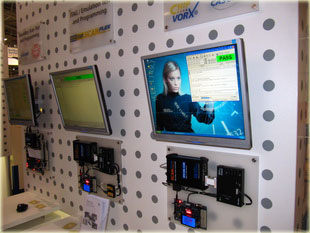ChipVORX® attracts a great attention at Electronica exhibition in Munich

Artur Jutman, 10th of November, Munich, exhibition grounds. "This is absolutely fantastic" - a typical feedback that I pleasantly hear from respected audience as we are displaying our Flash Accelerator IP and accompanyig software at the GOEPEL booth A1.351.
To be correct, GOEPEL electronic, a Jena, Germany based company is displaying the first ChipVORX® product (an ultra fast flash programmer) that we at Testonica Lab have proudly developed in very tight cooperation with GOEPEL electronic's engineers.
Personally, I see the greatest benefit to the customers in the product's unprecedented transparency and full backward compatibility with existing projects and workflows. A project, developed on a standard JTAG/Boundary Scan system, that involves flash programming can be accelerated at a typical factor of 10-15 times and in some cases up to 100x. The only thing a customer needs is to obtain the license and tick the box that says "Use Accelerator" in the properties of the test routine.
When it's done, the Flash Acelerator takes control and uploads a special pre-compiled instrument IP into the onboard FPGA. The instrument is then used to quickly pass the image from a file on the host computer to the flash IC on the board.
Of course, I forgot to mention that the board needs an FPGA device to be available on the board and the target flash IC needs to be attached to that FPGA. This is a typical case on modern complex electronic boards, though. Currently, we support all Xilinx and Altera devices, while working towards Lattice FPGAs.
In general, ChipVORX technology supports any kind of embedded instrumentation - softcore or a hardwired IPs, in an FPGA, ASIC or other IC chip. Essentially, it is a mechanism to control embedded test structures inside the board components via a standard JTAG port, an 1149.7 or P1687 compliant interfaces.
My academic background tells me that in theory it is possible to work with any interface or a bus, but the practical side of myself insist to hold on for a moment and listen to the real customer needs. During the exhibition, I was many times asked what is the difference between VarioTAP and ChipVORX. So, let's make it simple for the moment. Currently, if your board features a processor or an MCU, you should plan to use VarioTAP for extended Boundary Scan or functional test, but if there is an FPGA device on board, then go for ChipVORX. Also, follow the availability of the respective models on the Genesis site.
For standard ChipVORX applications, contact GOEPEL electronic's sales team, but if you need an extra performance or specific features to be added, turn to Testonica Lab for a customized ChipVORX application. We are eager to impress you!
See also a video report from Electronica 2010 exhibition by Karl Miles speaking about ChipVORX and TAP Checker
